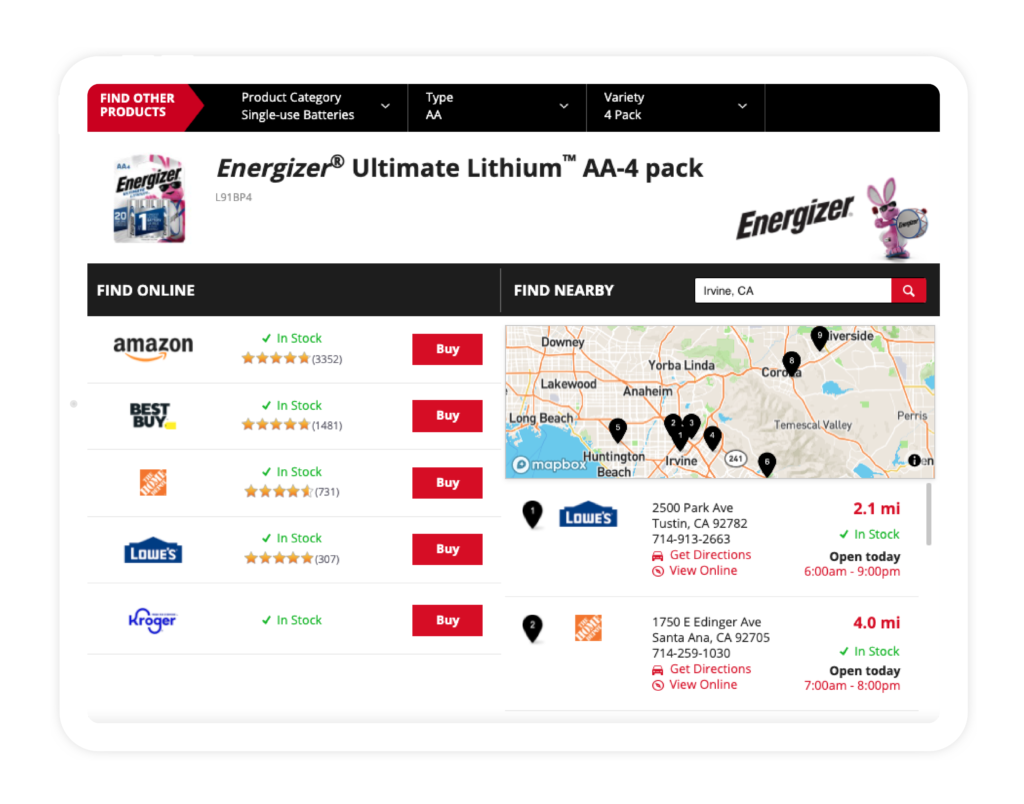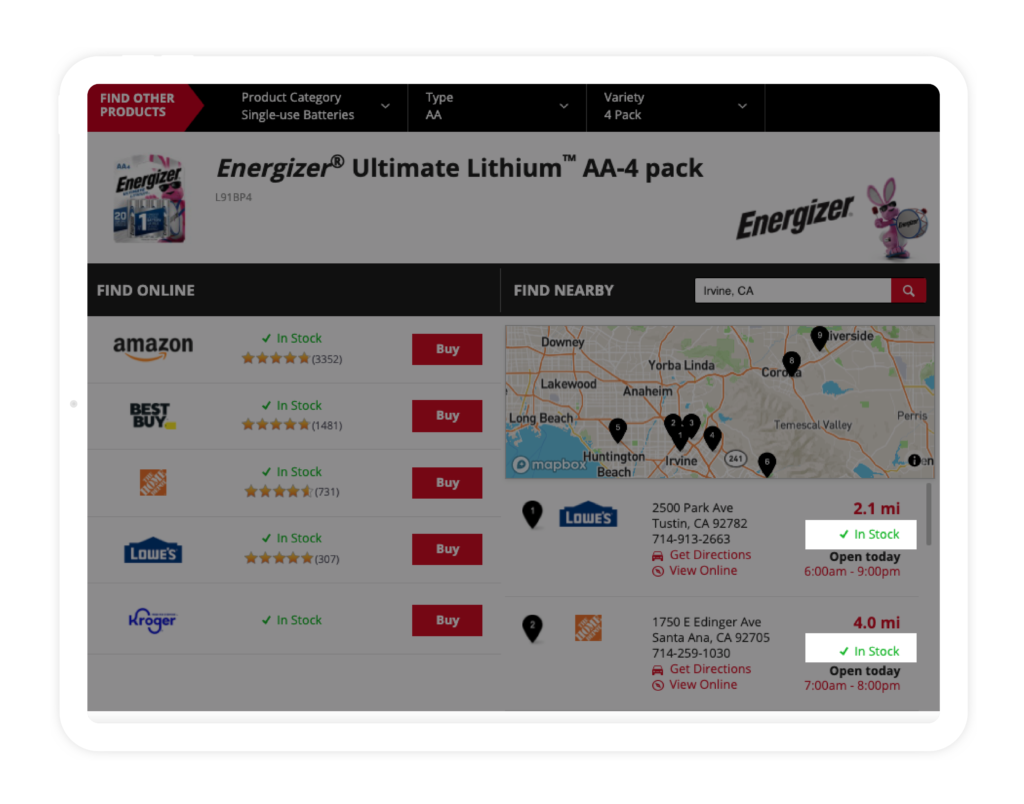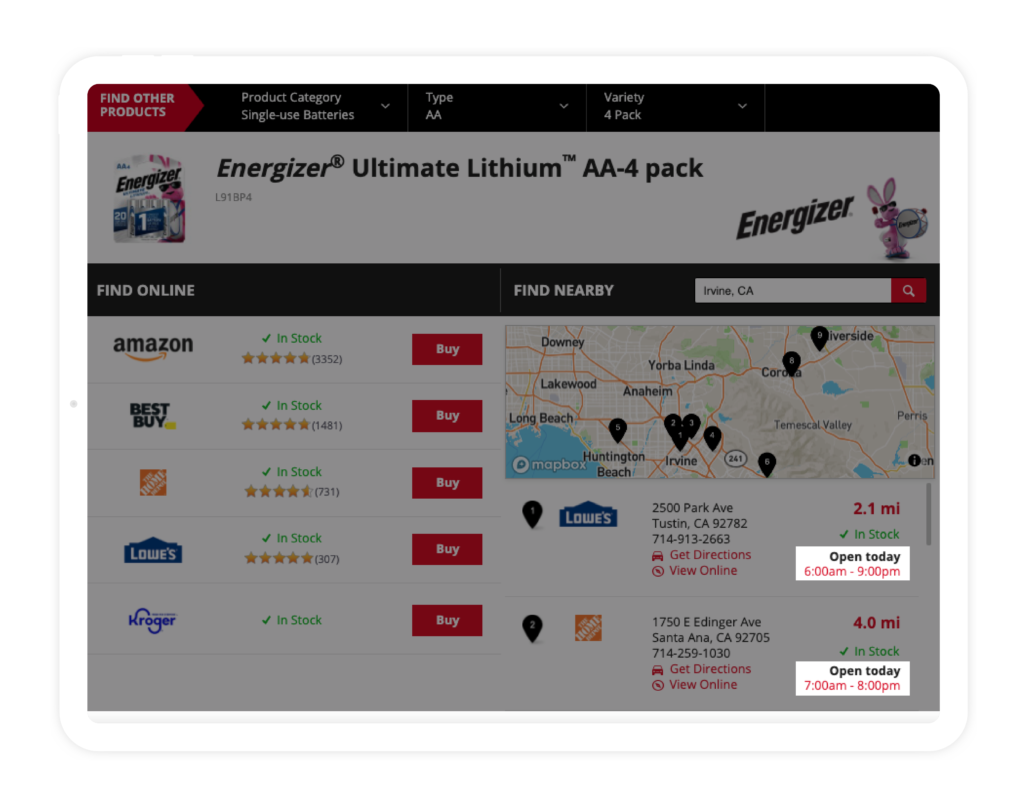Remember 8-track tapes? Back when they were a thing, you had to wait out every other song on an album for your jam to come back around. CDs were a revelation because you could skip ahead to the next song. Now with streaming music, you can listen to any song, any genre, anytime, anywhere. Thank you technology! We were living like cavemen back in the 8-track days. Similarly, once upon a time you had to walk to the nearest Tower Records to pick up the latest Destiny’s Child CD if it still happened to be in stock. Nowadays, we still need our new Beyonce releases but thankfully, like Bey, technology has come a long way, specifically by helping us find exactly what we’re looking for where and when we want it.
The journey begins when a website visitor decides to buy your product — their next step is to decide where to buy it. That’s where a store locator comes in. These specialized widgets display a map of nearby stores that carry the product they’re looking for, whether those stores belong to you or a retail partner.

Depending on your store locator software, your customers can search by ZIP Code, city, or even just using their current location. The store locator then displays locations that best match their criteria.
A store locator creates a direct path from your website to the place where your customers will ultimately make their purchase. Your customers stay in the driver’s seat while you simply show them where to go.
PriceSpider’s store locator software is called Where to Buy — because that’s the decision we help your customers make. Nearly 2,000 brands use Where to Buy to maximize conversions on their websites and streamline the path to purchase.
Want to check it out? You can schedule a demo here.
In this article, we’ll walk you through the key capabilities to look for in a store locator and how shoppable media elevates it to the next level. But first: why do you need one?
Some customers want to buy your products locally
Store locators serve a very specific type of customer: people who want to buy your product locally. Whether they use a buy online, pickup in store (BOPIS) option or simply buy it in store, they don’t want to wait (or pay) for shipping. They want your product today.
So they need to know where they can go to pick it up.
Without a store locator, you’re leaving a massive gap in your customer journey, forcing these customers to look elsewhere to figure out their local pickup options. If they don’t give up, the best you can hope for is that they’ll turn to Google or use a local retailer’s search engine.
Not only do these extra steps expose them to ads from your competitors and other product pages that show up in search results, you run the risk that they’ll hit a dead end. Maybe they check their local Walmart only to find that they don’t carry your product, forcing them to start over with another store. However, if you had a store locator, they would have seen right away that the Rite-Aid across the street from Walmart carries exactly what they were looking for.
Adding a store locator to your website is ultimately about simplifying the path to purchase. You’re reducing the need for your visitors to bounce between websites as they explore local options, removing friction and increasing the likelihood that they’ll convert, online or offline.
Now let’s look at some of the features you should look for in a store locator software.
Show more than your store locations
The main goal of adding a store locator to your website is obviously to help customers find stores near them. But location isn’t the only information your customers need to make the right choice. If your store locator only shows location (or doesn’t update frequently), you risk sending customers to a store where that doesn’t actually have your product.
You can offer many other pieces of valuable information that keep customers moving down the path of purchase toward the ultimate goal of converting the sale. Here are some of the most important pieces of shoppable information you should be providing on your store locator.
Stock availability

Imagine if a customer used your store locator and saw that a nearby Target carried your product. So they get in the car or walk to the bus stop, travel 20 minutes to the store, and discover that while Target carries your product, their store was out of stock.
You might think, “Well, they should’ve clicked through to Target’s store, where they would’ve seen that it was out of stock.” But that’s not how the customer will see it. They’ll blame you for showing them that Target was an option.
In that worst case scenario, the customer has made a significant commitment to go buy a solution to their problem. So they’re going to choose the first competitor they find that meets their needs. The next time they need a product that you provide, they’re going to associate your brand with this bad experience. Even if they don’t, they’ll have had weeks, months, even years to get used to your competitor’s product.
If you don’t display stock availability, you risk losing some customers for good.
It’s also not enough to display stock information. You need your store locator to check stock availability frequently enough that it gives your customers current information. The moment your product is out of stock, that information needs to be reflected on your website. Not every store locator does this. In fact, some don’t even check stock availability on a daily basis!
PriceSpider Where to Buy uses our unique “spidering” technology to actively monitor your product pages on your retail partner’s websites. It displays real-time data, so when a retailer sells the last of their stock, your store locator knows and your customers don’t feel misled.
Store hours

Some customers use your store locator to figure out where they’re going to pick up your product the next day, after work, or over the weekend. Others are looking because they want to buy your product right now. They need to know which stores are open.
It’s easy for people to check store hours themselves, but displaying this information with your store locator simplifies the process for them. You don’t want to make them check your website, Google Costco’s hours, come back to your website, Google Best Buy’s hours, and so on until they find their preferred store that’s open at the right time.
Every time a customer leaves your website and is required to start their search over is an opportunity for you to lose the sale. Including hours of operation in your store locator removes the back and forth and positions your brand website as the most reliable place to look for your products.
Pricing information
Price is one of the biggest factors people use to determine where they will buy a product. If several local stores carry your product, displaying their prices saves customers the trouble of checking multiple websites and helps them make the best choice.
If you’re good at enforcing your pricing policy, customers should see consistent prices anywhere they shop for your products. But when you work with retailers and third-party sellers, there’s always going to be some variation. By including pricing information in your store locator, it’s easier for customers to comparison shop.
Buying options
When a local store offers curbside pickup, click and collect, BOPIS, or other special buying options, this can help customers choose between their options. Highlighting more convenient ways to buy your products can also help you increase conversions.
If your retailers facilitate additional buying methods, make sure your store locator software shares those options with your customers.
Ratings
When someone uses your store locator, they haven’t actually committed to buying your product yet. They might be 90 percent of the way there but still need some convincing. Displaying ratings in your store locator won’t necessarily influence where someone buys, but it could impact whether they buy at all.
If a shopper is on the fence about buying your product and they see that it has thousands of five-star ratings at Home Depot and Amazon, that may be enough to convince them. Of course, low ratings won’t do you any favors, so be sure you select a store locator that lets you control how and when you display ratings.
Product filters
Sometimes the product someone wants is in stock, but the configuration they were hoping for isn’t. If they want your product enough, they may not care if they get it in black or blue, or if it comes in a 6 pack or a 24 pack.
Your goal is to remove the hassle from finding local buying options. So make sure your store locator has product filters to empower customers to change their selection.
Customize your store locator
Your store locator should feel like a natural, intuitive part of your website. That only happens when you control how it looks and feels. With Where to Buy, you can modify your store locator to fit your website. Colors and text are fully customizable, so it looks like it was built in-house by your brand.
Help your customers find the store that’s right for them
Everyone has their own buying preferences. Some people choose stores they’re familiar with. Others choose buying options that fit their lifestyle. And when they want to buy in person, they choose the store locations that make the most sense for them.
Make your brand shoppable – beyond store locator software
Shoppable media is the next evolutionary step in store locator technology. Shoppable media includes any digital content that empowers consumers with the information they need to compare buying options and open up clear pathways to each store. Rather than placing a pin on a map and praying shoppers will follow through and find your product in the wild, you can use shoppable media to eliminate the footwork of tracking down price comparison, stock availability, pick-up options, store information, customer ratings, and other critical pieces of the buying journey. Shoppable media places this augmented experience anywhere your customers shop, from your brand website to social to mobile ads and even on physical packaging. And once customers are interacting with and funneled through your shoppable media, a whole new world of analytics and tracking is unlocked, offering your business insights to improve conversions like you’ve never seen before.
Adding a store locator enhanced with the power of shoppability to your website and everywhere else your customers shop is about saving them the trouble of hunting for the information they need and controlling the path to purchase. Make it easier for your customers to buy according to their preferences by providing all the information they need in one place.
Want to see how it works? Schedule a demo of Where to Buy.

